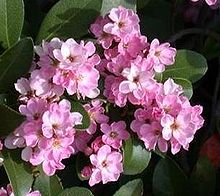| Rhaphiolepis indica | |
|---|---|

| |
| Indian hawthorn in bloom | |
|
Scientific classification
| |
| Kingdom: | Plantae |
| Clade: | Tracheophytes |
| Clade: | Angiosperms |
| Clade: | Eudicots |
| Clade: | Rosids |
| Order: | Rosales |
| Family: | Rosaceae |
| Genus: | Rhaphiolepis |
| Species: | R. indica
|
| Binomial name | |
| Rhaphiolepis indica | |
Rhaphiolepis indica, the Indian hawthorn, India hawthorn or Hong Kong hawthorn is an evergreen shrub in the family Rosaceae.
Description
They are shrubs or small trees, which rarely reach a size of 4 m in height. The branches are purple brown when young, greyish brown when old, cylindrical, initially brown tomentose, glabrous in old age. Petiole 0.5–1.8 cm or almost absent, slightly brown or tomentose, subglabrous; stipules deciduous, lanceolate, little brown tomentose, acuminate apex; ovate blade blade, oblong, rarely obovate, oblong-lanceolate, narrowly elliptical or elliptical-lanceolate, (2–) 4–8 × 1.5–4 cm, coriaceous, abaxially prominent veins, abaxially visible reticular veins and visible or non-adaxially, back pale, glabrous or scarcely tomentose, shiny adaxially, glabrous, the apex obtuse, acute acuminate.
The inflorescences in panicles or terminal of clusters, with many or few flowers; pedicels and peduncles rusty-tomentose; bracts and deciduous bracteoles. Flowers 1–1.5 cm in diameter. The petals white or pink, obovate or lanceolate, 5–7 × 4–5 mm, pubescent basal, obtuse apex. Stamens 15, as long or shorter than the petals. [1]
Range
It is found on slopes, roadsides, bushes on the sides of streams; at an altitude of 700–1600 meters above sea level in an areas such as, southern China, Japan, Laos, Cambodia, Thailand and Vietnam. [2]
Cultivation and uses
It is grown for its decorative pink or white flowers, and is popular in bonsai culture. The fruit is edible when cooked, and can be used to make jam.[ citation needed]
Indian hawthorn is a mainstay horticultural specimen in southern United States. It is often found in commercial as well as in private landscapes. Often it is trimmed into small compact hedges or balls for foundation plants. It has been successfully pruned into a standard form as well as small dwarf-like trees up to 15 feet in height. It is apt to develop leaf spot. [3]
Dyeing
The plant is also known as "teechigi" and its pulp is known as "sharinbai" (しゃりんばい / テーチ木 / テカチ木) in Japan and a dark brown dye is made by boiling its dried bark or root and using iron or lime water as a mordant. This plant has been used in Japan for over 400 years in a technique for making pongo silk fabrics. In the Kainan islands in China it is used to make shima-tsumugi textiles and some fishing nets. [4] Additionally, the plant is used in a Japanese mud dyeing technique known as dorozome from the Amami Islands. In dorozome, branches are chopped into small chips and simmered in large cauldrons for two days. The pulp is then filtered out and yarn is steeped in the golden-orange extract. The more the yarn is dipped and dried, the darker and richer the color is. [5]
Gallery
-
An Indian hawthorn bush at a distance
-
Rhaphiolepis indica blooming in Hong Kong
-
Specimen in Hong Kong
-
In Las Vegas
References
- ^ Flora of China Editorial Committee. 2003. Fl. China 9: 1-496. Science Press & Missouri Botanical Garden Press, Beijing & St. Louis.
- ^ Cuizhi Gu; Chaoluan Li; Lingdi Lu; Shunyuan Jiang; Crinan Alexander; Bruce Bartholomew; Anthony R. Brach; David E. Boufford; Hiroshi Ikeda; Hideaki Ohba; Kenneth R. Robertson & Steven A. Spongberg. "Rhaphiolepis indica". Flora of China. Vol. 9.
- ^ "Managing Pests in Gardens: Trees and Shrubs: India Hawthorn—UC IPM". ipm.ucanr.edu. Retrieved 2024-02-26.
- ^ "Sharinbai (Yeddo-Hawthorn) - center (90 C)". Conservation and Art Materials Encyclopedia Online (CAMEO). Retrieved 28 January 2021.
- ^ "Dorozome: Japanese Mud Dyeing". Retrieved 28 January 2021.
![]() Media related to
Rhaphiolepis indica at Wikimedia Commons
Media related to
Rhaphiolepis indica at Wikimedia Commons



